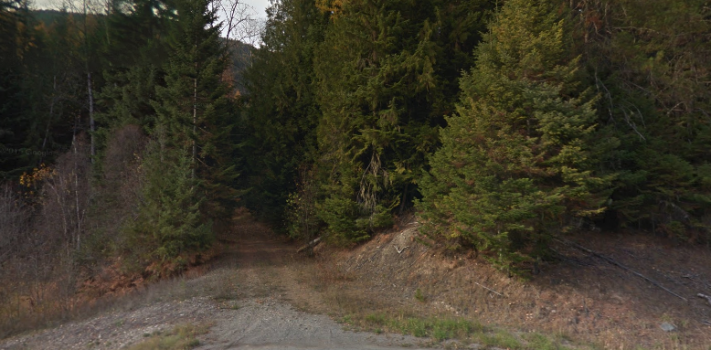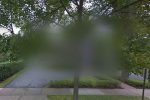Today I’m providing an update and expansion to an article that I posted back in early 2009.
This is something that I first shared with a few of my consulting clients. It is an approach at rural retreat construction that can make a rural retreat of 10 acres or more essentially “disappear”.
House SitEs and Road Building
 If there is a thick screen of trees or tall brush between the public road and potential building sites at your undeveloped country retreat parcel, then your property might have a good candidate for a “hidden retreat house”. This is accomplished by making as few changes as possible when the parcel is viewed from the county road. No fancy entry gate, no mailbox, basically nothing new that is visible except a small diameter drainage culvert by the side of the county road and a narrow semi-improved road that will just look like a disused farm machinery access lane. Hopefully, there isn’t already a “lip” in the road (as shown, above) that can make a small and otherwise unobtrusive lane look more prominent. County and state highway paving crews often add lips, “as a courtesy” to landowners.
If there is a thick screen of trees or tall brush between the public road and potential building sites at your undeveloped country retreat parcel, then your property might have a good candidate for a “hidden retreat house”. This is accomplished by making as few changes as possible when the parcel is viewed from the county road. No fancy entry gate, no mailbox, basically nothing new that is visible except a small diameter drainage culvert by the side of the county road and a narrow semi-improved road that will just look like a disused farm machinery access lane. Hopefully, there isn’t already a “lip” in the road (as shown, above) that can make a small and otherwise unobtrusive lane look more prominent. County and state highway paving crews often add lips, “as a courtesy” to landowners.
For a hidden retreat, your road should be just lightly road-rocked for the first 100 feet, to encourage grass to actually grow up in it. Design the roadway leading to the back end of the property to be narrow and in a serpentine path, so that additional trees can be planted to block any view down the lane. You will of course need to brief and oversee your road-building contractors, so that they don’t do the usual “wide, well-cleared road, with lots of rock.”
The key words are: Narrow, Uninviting, and Nothing of Value to steal. Those are the impressions that you want to lave with passers-by. And when I say narrow, I mean: So narrow that the bushes might scratch the paint on a standard-size pickup. If in doubt: Plant more trees. But take note that if you plant non-native tree species that they will actually stand out.
Either have grid power established with an underground line, or skip it altogether and put in a photovoltaic (PV) power system. Thus, there are no power poles and visible lines to follow and give away the location. And again: No mailbox!
If it is feasible and affordable, I recommend building a masonry house with small windows and with either a native rock or an earth-tone facade. The roof should be green metal — all the better to blend in. Do not clear trees to “open up a view”, since that would likely provide line of sight from any nearby roads, revealing the house.
 The aforementioned measures might all seem a bit “Bat Cave”, but I have indeed seen this approach used effectively at a 30-acre retreat on the Big Island of Hawaii. His lane just looks like a narrow break in a sugarcane field that is designed to accommodate tractors. Anyone approaching it in a car or truck would think: “There will be no place for me to turn my vehicle around.” The owner — who has owned the property since 1997 — mentioned that a few of his neighbors’ houses have been burglarized, but that his house has never been. The house is invisible from the public road and from all of the neighboring houses. So opportunistic burglars “just passing through” don’t even know that there is a house there. Again, his lane just looks like something used by farm tractors, not by a homeowner.
The aforementioned measures might all seem a bit “Bat Cave”, but I have indeed seen this approach used effectively at a 30-acre retreat on the Big Island of Hawaii. His lane just looks like a narrow break in a sugarcane field that is designed to accommodate tractors. Anyone approaching it in a car or truck would think: “There will be no place for me to turn my vehicle around.” The owner — who has owned the property since 1997 — mentioned that a few of his neighbors’ houses have been burglarized, but that his house has never been. The house is invisible from the public road and from all of the neighboring houses. So opportunistic burglars “just passing through” don’t even know that there is a house there. Again, his lane just looks like something used by farm tractors, not by a homeowner.
 A few years ago, I had a consulting client in an eastern state who owns a retreat in a region with dense woods tell me that he refurbished a hunting cabin (or “Camp”), as they are called locally. This cabin, on 20-odd acres, sat at the end of a lane that was so narrow that his real estate agent had trouble finding it, even with provided driving directions and GPS. The cabin had not been used at all in several years, so the lane had shin-high grass and was nearly overgrown by encroaching trees. As they walked in, the agent said: “Well, you can have someone come here with chainsaws and clear this out, in a jiffy.” He bought the cabin with cash but then he intentionally left the lane just as it was.
A few years ago, I had a consulting client in an eastern state who owns a retreat in a region with dense woods tell me that he refurbished a hunting cabin (or “Camp”), as they are called locally. This cabin, on 20-odd acres, sat at the end of a lane that was so narrow that his real estate agent had trouble finding it, even with provided driving directions and GPS. The cabin had not been used at all in several years, so the lane had shin-high grass and was nearly overgrown by encroaching trees. As they walked in, the agent said: “Well, you can have someone come here with chainsaws and clear this out, in a jiffy.” He bought the cabin with cash but then he intentionally left the lane just as it was.
 Out west, the woods tend to be less dense, but they are largely coniferous. This is an advantage, since the trees don’t drop leaves, in the winter. In contrast, many “hidden” houses in eastern states can be seen quite clearly, when the deciduous leaves are down. When doing some land-buying research on behalf of consulting clients, I’ve found a few properties in wooded, mountainous areas that have nearly unrecognizable access roads. In most cases, I haven’t seen these properties in person. Rather, I’ve only seen them through the use of Google Street Views imagery. (I’ve included a few such images of similar lanes in this article.)
Out west, the woods tend to be less dense, but they are largely coniferous. This is an advantage, since the trees don’t drop leaves, in the winter. In contrast, many “hidden” houses in eastern states can be seen quite clearly, when the deciduous leaves are down. When doing some land-buying research on behalf of consulting clients, I’ve found a few properties in wooded, mountainous areas that have nearly unrecognizable access roads. In most cases, I haven’t seen these properties in person. Rather, I’ve only seen them through the use of Google Street Views imagery. (I’ve included a few such images of similar lanes in this article.)
Speaking of Google Street Views, property owners can request that the view of their address or even just their parked vehicle be blurred. That may or may not be an advantage. If you do so and you are the only one in many miles to have a place blurred out, then it might actually call attention to your dwelling. You can see an example of a blurred street view, below:
Neighbors Will Still Know
Granted, the approach that I’ve described will not protect your retreat from being known by your neighbors. Twelve-year-old boys tend to hike around just about everywhere, and they pay little attention to “No Trespassing” signs. Ditto for a lot of hunters and quite a few fishermen. But statistically, a hidden retreat will be much safer, both before the Schumer hits the fan, and after.
An even more elaborate disappearing act is to build a fully underground house with a hidden entrance and air vents hidden in what appears to just be a utility building, such as a large pump house, a tractor shed, or workshop. But, of course, that gets much more expensive.
I look forward to your comments via e-mail. As space permits, I will post them in the next Snippets column.











